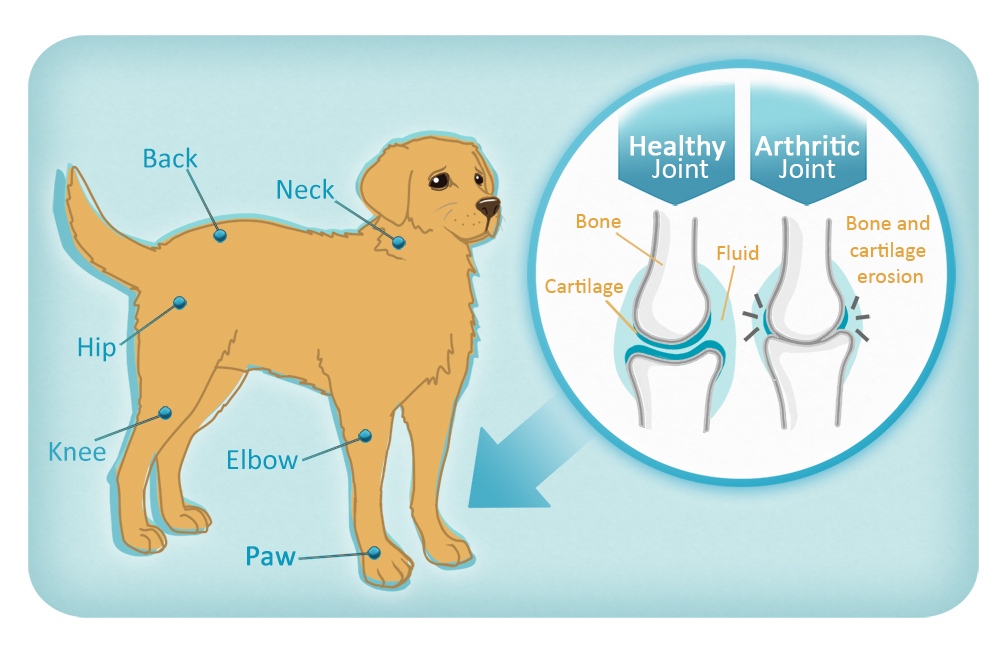Arthritis in dogs: answers to common questions

It is well known that arthritis affects millions of people in the UK, but many of us don’t realise that it is also a common ailment among dogs. Here we answer some of the most common questions pet owners have about the condition and share some tips on how to improve your senior dog’s quality of life.
- What is canine arthritis?
- Can I prevent my dog from developing arthritis?
- What are the signs of arthritis in dogs?
- How soon should I seek treatment?
- What are the different kinds of arthritis?
- How do I treat my dog’s arthritis?
- What is canine arthritis?
Arthritis is a catch-all term for a number of different conditions affecting your dog’s joints, many of which develop with age. There are a variety of different causes, symptoms and treatments.
Dogs are living longer thanks to improvements in diet and care, which means that more of them are developing arthritis. A 2018 osteoarthritis study of more than 450,000 dogs estimated that the most common form, osteoarthritis, affects 200,000 animals in the UK including 7.7% of Golden Retrievers, 6.1% of Labradors, 5.4% of Rottweilers and 4.9% of German Shepherds.

Can I prevent my dog from developing arthritis?
If your dog is from a breed that commonly suffers from arthritis, you can help to prevent the disease from developing.
Arthritis can be extremely uncomfortable and painful for your dog. It is expensive to treat, and there is currently no cure, so it is best to prevent it for as long as possible. Here are a few steps you can take:
Feed your dog a healthy diet. Being overweight or obese seriously increases the risk of developing arthritis as the excess weight puts pressure on the joints.
Ensure your dog is getting the right amount of exercise. This will help to keep them lean and help them to develop muscle that supports the joints.
On the other hand, you should also avoid over-taxing your dog or doing too many activities that put strain on the joints (e.g. anything that involves a lot of jumping).
Try to stop your dog suffering a musculoskeletal (orthopaedic) injury - for example, to the shoulder or knee - because these injuries increase the likelihood of developing arthritis in the affected joint. You can do this by having floors in your house that the dog can grip and keeping your dog on a lead where appropriate to avoid accidents and fights.
If your dog does have an orthopaedic injury you should ensure it is treated immediately and that your dog also has physical therapy to aid with healing when this is recommended by your vet.
Keep your dog comfortable. Lying on a hard floor or in cold, draughty rooms is hard on the joints.
Even if your dog does eventually develop the disease, you can help by being aware of the signs and symptoms so you can spot it early on. Arthritis is degenerative, meaning that your dog’s joints become damaged over time; this permanently reduces function and increases discomfort.
By catching the disease before it has done too much harm you can provide appropriate help and treatment through medicine and lifestyle changes. This will help your dog to stay happy and healthy for longer.
What are the signs of arthritis in dogs?
Your dog may have arthritis if he or she:
develops a limp/favours one or more legs
seems stiff when getting up
has changed the way they sit
moves more slowly, and tries to avoid physical activity
no longer enjoys taking a walk
has swollen joints that may be warm to the touch
licks their joints
needs more sleep
seems more bad tempered than before
You might notice that your dog exhibits more of these symptoms in cold or wet weather, or when they first start to exercise.
How soon should I seek treatment?
Unlike human beings, who might ask for help when experiencing an illness, animals are more likely to try and conceal signs of weakness. Dog owners should keep a sharp eye out for any signs of arthritis, and should be aware that their pet may have been experiencing discomfort for a long time before allowing symptoms to show.
Arthritis is a degenerative condition which worsens if your dog does not receive treatment. It can cause the destruction of cartilage, so that eventually bone will grate on bone with every movement. For that reason you should consult a veterinarian if you suspect your dog might be developing arthritis.
What are the different kinds of arthritis?
Osteoarthritis
Osteoarthritis, also called degenerative joint disease, is the most prevalent form.
This condition usually affects one or two joints. It causes progressive damage to the cartilage surrounding them. Over time, the cartilage can wear away so much that the bones in the joint rub together -- this causes extreme discomfort. Other symptoms include inflammation or thickening of the joint capsule, excess fluid and swelling.
Osteoarthritis can be caused by natural wear and tear, previous injuries, genetic factors and developmental disorders.
Canine rheumatoid arthritis
Canine rheumatoid arthritis, also known as immune-mediated polyarthritis, is an inflammatory condition. It occurs when the immune system mistakenly identifies the cells in a joint as 'hostile' and attacks them.
This condition causes severe inflammation, tenderness and swelling. Joints often feel 'hot'.
Septic arthritis
This form of arthritis results from the bacterial infection of a joint. The infection itself is usually caused by a wound, allergy or bad reaction to a medicine.
Septic arthritis is a serious condition which is usually handled with antibiotics. If you suspect your pet has contracted it, you should consult your vet for emergency treatment.
How do I treat my dog’s arthritis?

If you believe that your dog has arthritis, you should consult your veterinarian immediately. The sooner your dog receives treatment, the less damage the disease will cause to his joints.
Vets will often try to determine which joints are affected by arthritis by examining your dog and performing tests; this may also reveal the cause of the disease. They often prescribe painkillers and anti-inflammatory drugs to relieve symptoms.
There are also other treatments that may improve your dog’s quality of life:
Keep up with exercise. Although your dog may not be so keen to exercise due to joint problems, continuing to exercise (though perhaps not as much) will help to keep them mobile and reduce symptoms.
Use a dog stroller, wheelchair or sling. These products can help your dog to stay more comfortable while exercising.
Maintain your dog’s weight. If your dog puts on weight, this will put more pressure on their joints.
Try other/alternative therapies. Some people choose to give their dog additional treatments to help with pain and mobility such as physiotherapy or even acupuncture.
Follow a healthy diet for joints. The right nutrients incorporated into your dog's diet may help with mobility and joint health over time. Omega-3 fatty acids (found in krill and fish oils) and turmeric are both popular options.
Summary
You can recognise arthritis in your dog through symptoms such as limping or swollen joints. If you suspect your dog might have the condition you should consult your vet and begin treatment as soon as possible to help your pet live a longer and more comfortable life. You might also like to give your dog supplements or look into alternatives such as physiotherapy
